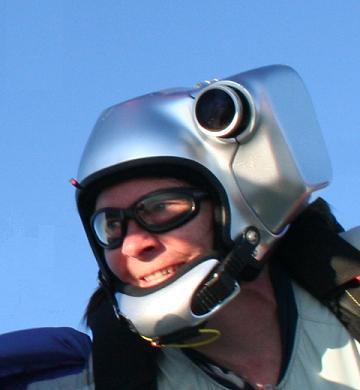Recommended Posts
billeisele 130
all above is good advice
check with your instructors, they are the best judge of what would be best
then check with a rigger to make sure what you are considering will "fit" together, it is possible to buy components that are not compatible
check with your instructors, they are the best judge of what would be best
then check with a rigger to make sure what you are considering will "fit" together, it is possible to buy components that are not compatible
Give one city to the thugs so they can all live together. I vote for Chicago where they have strict gun laws.
Step one is to know what your exit weight is. This is your body weight, plus clothing, plus the full weight of your rig ( normally 25 - 30 pounds ), added all together to get your exit weight. How heavy you sit under an open canopy, compared the the canopy size ( example: exit weight = 200 pounds / canopy size = 210 square feet ) is called your wingload. Your wingload as a beginner should be light. The "example" wing load is .95 / 1 . Your reserve canopy should have the same light wingload. Canopy type is important. Nothing high performance ( ellipticals or semi-ellipticals )Then you buy a container that will hold the sized canopies you bought, and one that fits your body.Your instructor might suggest a lighter or heavier wingload. Make sure to ask him / her before you buy.
Life is short ... jump often.
Bodhi1 0
Thanks. This is all good info, I definitely didn't know that some items would not be compatible with others. I wont be buying for a while, but I'm just trying to learn what I can before I get to that point. I've read a lot of other threads saying to consult my instructor, so I definitely plan on doing that before I decide what size gear to buy. I just had no idea If i should look to buy the items separate or to just wait for a complete rig.......and then, how do I know if it's even in working condition before I buy it? It would be ideal to meet someone face to face at the local DZ so I could get the rigger to look at it before I buy it, but I wouldnt guess that the chances are high for me to find something that fits me perfectly, used, and in my local area.
Peace and Love
labrys 0
QuoteNothing high performance ( ellipticals or semi-ellipticals )
There are quite a few semi eliptical canopies that are perfectly acceptible for novice jumpers when wing loading is appropriate
The Pilot, Hornet, and Sabre2 for example...
ETA: Isnt the Navigator semi eliptical too?
Owned by Remi #?
Crohnie 0
Find a rigger that you trust and check with them before purchasing for things like compatibility and appropriateness. Also you can have them act an an intermediary for your transactions
I just pieced together a system and all the transactions went something like: me putting a deposit down for the item to be shipped to my rigger and after inspection, I sent the rest of the money to the seller and the item was released to me. This is pretty standard and takes some of the possibility for scam/theft out of the equation.
And I can't speak to cost of complete vs pieced together, but in my experience I found it much easier to piece canopies with the proper container/harness size separately than to find a complete that would fit me and the canopies I was looking for.
Good luck.
I just pieced together a system and all the transactions went something like: me putting a deposit down for the item to be shipped to my rigger and after inspection, I sent the rest of the money to the seller and the item was released to me. This is pretty standard and takes some of the possibility for scam/theft out of the equation.
And I can't speak to cost of complete vs pieced together, but in my experience I found it much easier to piece canopies with the proper container/harness size separately than to find a complete that would fit me and the canopies I was looking for.
Good luck.
Check out Chutingstar's Expert Advice:
Look first at the "Buying Gear - Latest Articles" items:
http://www.chutingstar.com/expertadvice_en/
Look first at the "Buying Gear - Latest Articles" items:
http://www.chutingstar.com/expertadvice_en/
My reality and yours are quite different.
I think we're all Bozos on this bus.
Falcon5232, SCS8170, SCSA353, POPS9398, DS239
I think we're all Bozos on this bus.
Falcon5232, SCS8170, SCSA353, POPS9398, DS239
finding a complete rig with all the components that are right for you may be tough. i recently got a great deal on a used great used main. i also found a nice reserve for a good price. In my lowly opinion the canopies are the easy part. I tried a bunch of containers but nothing fit me well enough for me to be comfy jumping in safely. I wound up ordering a custom container to fit my not average build. If you have an average build you have a much better chance of finding a container that fits. Good luck and blue skies!!!!
Wait , I pull what first?
QuoteDo I just go to my local certified rigger and ask them to help me get it all together so that my rig is set up correctly?
Just to be clear, a certified rig has to assemble and pack portions of the rig for it to be legal to jump. Other parts you can assemble yourself, although this isn't always a good idea. Beyond that, you rig will need to be repacked every 6 months, and some repairs will also require a rigger, so if you buy a rig you'll need a rigger during the purchase and moving forward.
Do consult your instructors as to what size main and reserve canopies you should be looking for. You can also keep them in the loop as you narrow your search to specific models and sizes to ensure they approve as per your abilities.
Beyond that, use the rigger to inspect everything before buying. The rigger will also make sure that the components are compatible, and that there are no recalls or service bullitens that need to be addressed.
Bodhi1 0
I had no idea that the riggers would help out with this much stuff. This is great information. It definitely make me feel a lot better about purchasing a used rig. I'm even luckier I guess that My instructor is also a certified rigger. Thanks for all of the information everyone.
Peace and Love
QuoteI had no idea that the riggers would help out with this much stuff
Some riggers will charge for inspections on used gear, and they are completely justified in doing so. Their time and expert opinion have a great deal of value in this area.
Some riggers will waive the inspection fees, and charge only for assembling and packing the rig once you have it.
In either case, it's a chance for both you and the rigger to establish a business relationship. You are going to need a rigger, and one who knows your gear and it's history is an asset to you. The rigger gets a customer that will be back at least every six months, but probably more often for repairs or modifications.





Yes, and to add to that, it's really beneficial to consult someone you know and trust, one of your AFF instructors perhaps, before you actually purchase something you've found, someone's who's impartial and most concerned about your safety and progression. They might be able to answer questions you didn't even know you should be asking.
Share this post
Link to post
Share on other sites